MNG01222 Facility & Risk Management Analysis of IBIS Hotels Melbourne
VerifiedAdded on 2023/04/26
|20
|3939
|319
Report
AI Summary
This report assesses risk management at IBIS Hotels Melbourne, beginning with a literature review of risk management processes, particularly within the hospitality sector. It highlights the unique challenges hotels and resorts face due to their service-oriented nature. The report includes a practical application involving Ibis Hotels Melbourne, where various risk sources are identified, ranked, and analyzed using VRA to pinpoint high-risk areas. The analysis covers physical, financial, human, and intangible risks, providing a detailed risk rating system. Finally, the report offers recommendations aimed at enhancing the risk management framework at Ibis Hotels, focusing on improving safety, financial stability, employee relations, and brand image.
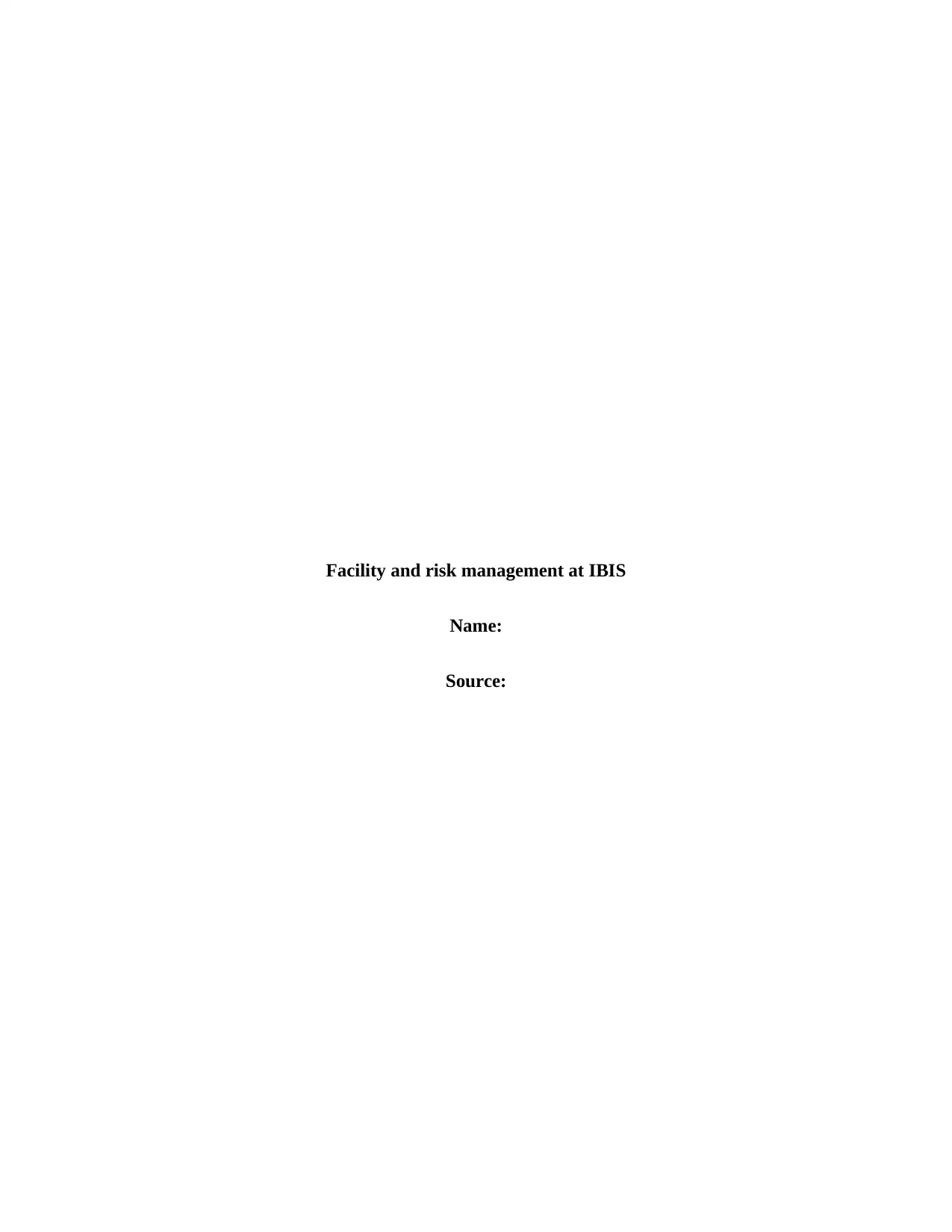
Facility and risk management at IBIS
Name:
Source:
Name:
Source:
Paraphrase This Document
Need a fresh take? Get an instant paraphrase of this document with our AI Paraphraser
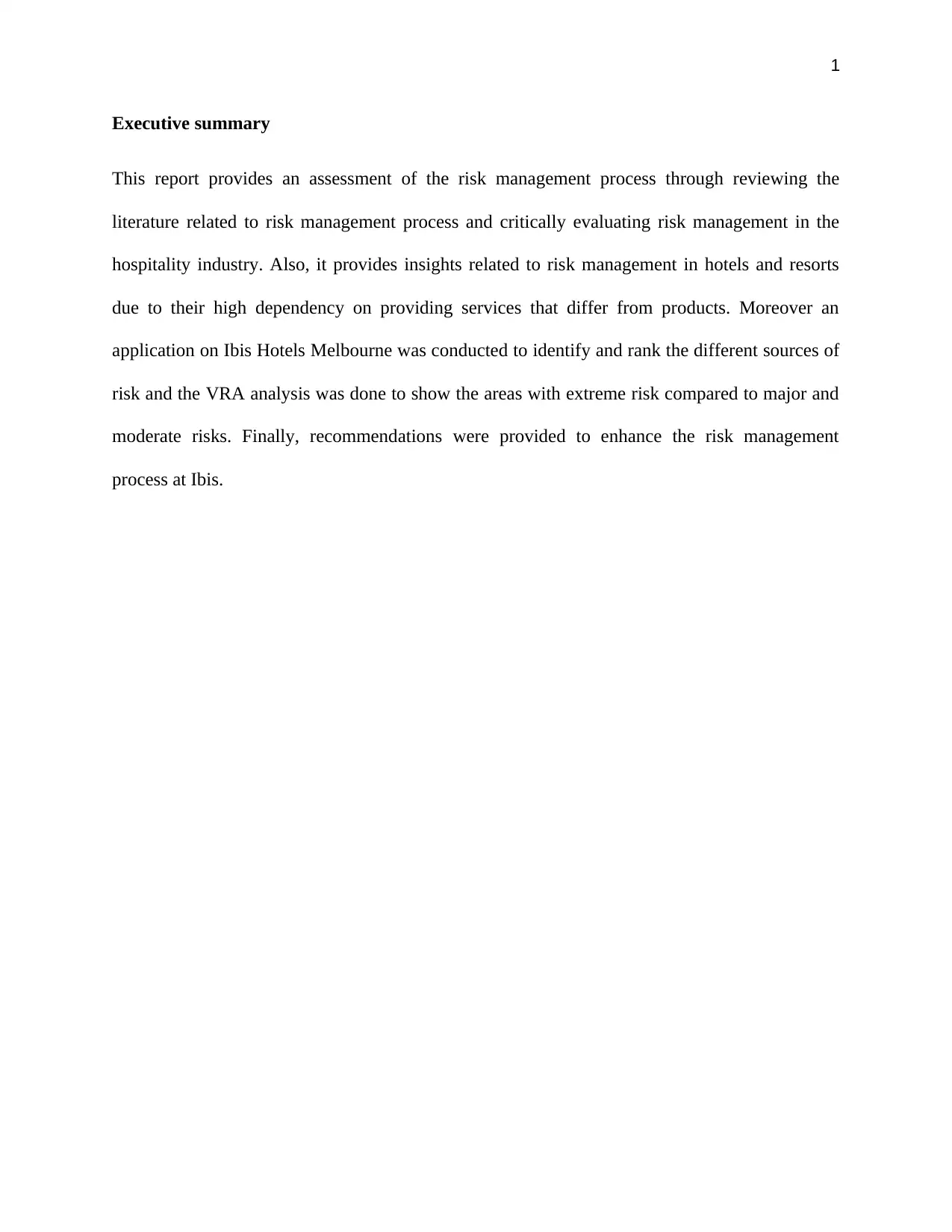
1
Executive summary
This report provides an assessment of the risk management process through reviewing the
literature related to risk management process and critically evaluating risk management in the
hospitality industry. Also, it provides insights related to risk management in hotels and resorts
due to their high dependency on providing services that differ from products. Moreover an
application on Ibis Hotels Melbourne was conducted to identify and rank the different sources of
risk and the VRA analysis was done to show the areas with extreme risk compared to major and
moderate risks. Finally, recommendations were provided to enhance the risk management
process at Ibis.
Executive summary
This report provides an assessment of the risk management process through reviewing the
literature related to risk management process and critically evaluating risk management in the
hospitality industry. Also, it provides insights related to risk management in hotels and resorts
due to their high dependency on providing services that differ from products. Moreover an
application on Ibis Hotels Melbourne was conducted to identify and rank the different sources of
risk and the VRA analysis was done to show the areas with extreme risk compared to major and
moderate risks. Finally, recommendations were provided to enhance the risk management
process at Ibis.
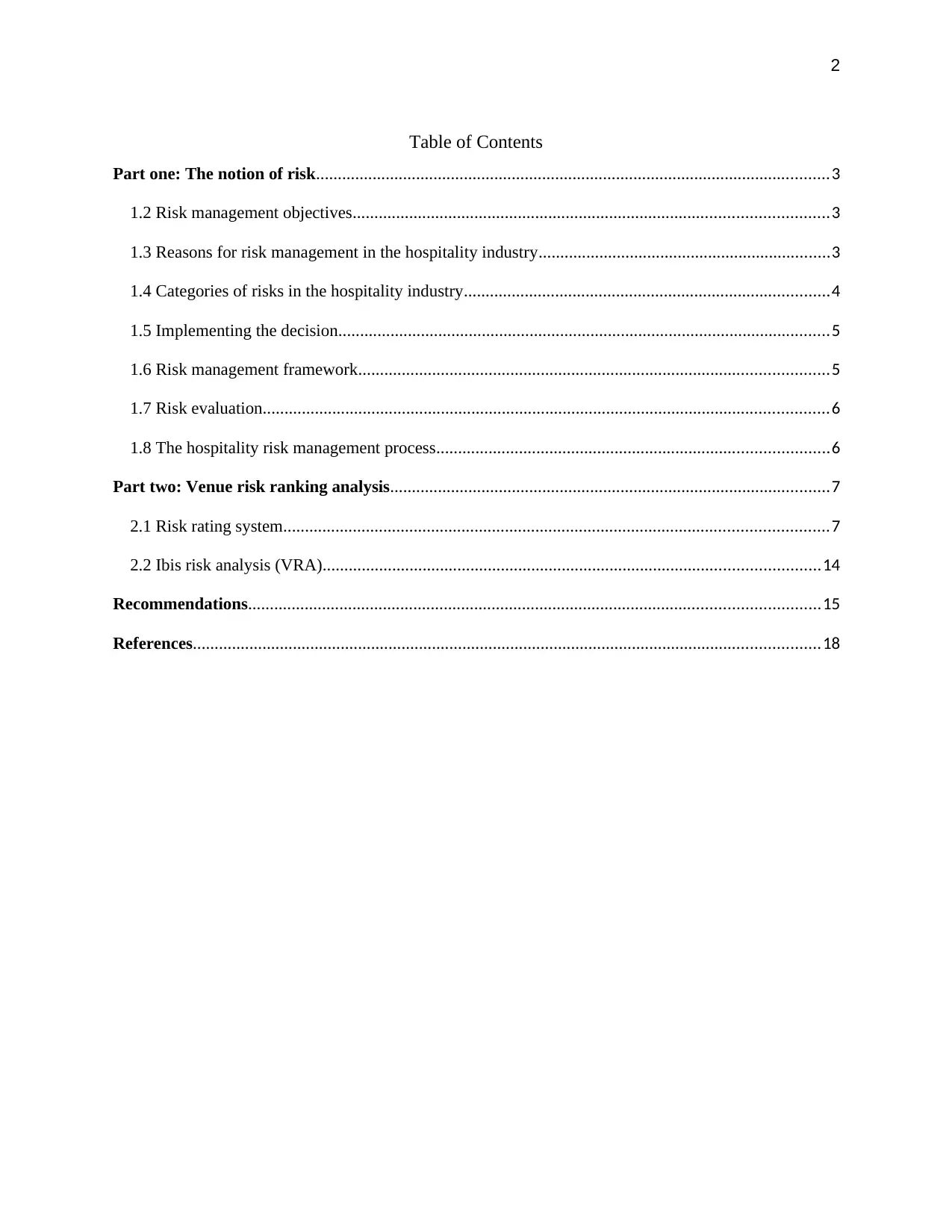
2
Table of Contents
Part one: The notion of risk......................................................................................................................3
1.2 Risk management objectives.............................................................................................................3
1.3 Reasons for risk management in the hospitality industry...................................................................3
1.4 Categories of risks in the hospitality industry....................................................................................4
1.5 Implementing the decision.................................................................................................................5
1.6 Risk management framework............................................................................................................5
1.7 Risk evaluation..................................................................................................................................6
1.8 The hospitality risk management process..........................................................................................6
Part two: Venue risk ranking analysis.....................................................................................................7
2.1 Risk rating system.............................................................................................................................7
2.2 Ibis risk analysis (VRA)..................................................................................................................14
Recommendations...................................................................................................................................15
References................................................................................................................................................18
Table of Contents
Part one: The notion of risk......................................................................................................................3
1.2 Risk management objectives.............................................................................................................3
1.3 Reasons for risk management in the hospitality industry...................................................................3
1.4 Categories of risks in the hospitality industry....................................................................................4
1.5 Implementing the decision.................................................................................................................5
1.6 Risk management framework............................................................................................................5
1.7 Risk evaluation..................................................................................................................................6
1.8 The hospitality risk management process..........................................................................................6
Part two: Venue risk ranking analysis.....................................................................................................7
2.1 Risk rating system.............................................................................................................................7
2.2 Ibis risk analysis (VRA)..................................................................................................................14
Recommendations...................................................................................................................................15
References................................................................................................................................................18
⊘ This is a preview!⊘
Do you want full access?
Subscribe today to unlock all pages.

Trusted by 1+ million students worldwide
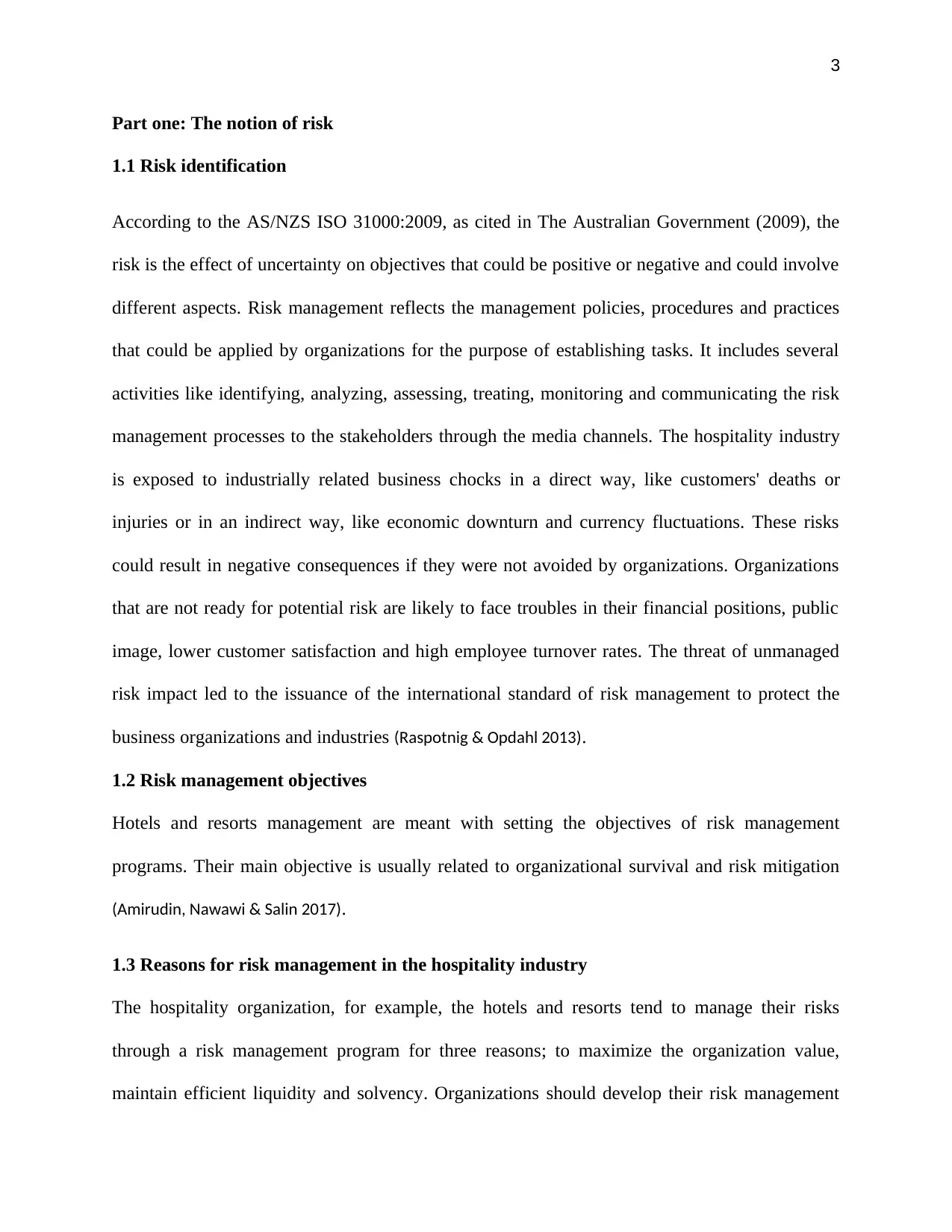
3
Part one: The notion of risk
1.1 Risk identification
According to the AS/NZS ISO 31000:2009, as cited in The Australian Government (2009), the
risk is the effect of uncertainty on objectives that could be positive or negative and could involve
different aspects. Risk management reflects the management policies, procedures and practices
that could be applied by organizations for the purpose of establishing tasks. It includes several
activities like identifying, analyzing, assessing, treating, monitoring and communicating the risk
management processes to the stakeholders through the media channels. The hospitality industry
is exposed to industrially related business chocks in a direct way, like customers' deaths or
injuries or in an indirect way, like economic downturn and currency fluctuations. These risks
could result in negative consequences if they were not avoided by organizations. Organizations
that are not ready for potential risk are likely to face troubles in their financial positions, public
image, lower customer satisfaction and high employee turnover rates. The threat of unmanaged
risk impact led to the issuance of the international standard of risk management to protect the
business organizations and industries (Raspotnig & Opdahl 2013).
1.2 Risk management objectives
Hotels and resorts management are meant with setting the objectives of risk management
programs. Their main objective is usually related to organizational survival and risk mitigation
(Amirudin, Nawawi & Salin 2017).
1.3 Reasons for risk management in the hospitality industry
The hospitality organization, for example, the hotels and resorts tend to manage their risks
through a risk management program for three reasons; to maximize the organization value,
maintain efficient liquidity and solvency. Organizations should develop their risk management
Part one: The notion of risk
1.1 Risk identification
According to the AS/NZS ISO 31000:2009, as cited in The Australian Government (2009), the
risk is the effect of uncertainty on objectives that could be positive or negative and could involve
different aspects. Risk management reflects the management policies, procedures and practices
that could be applied by organizations for the purpose of establishing tasks. It includes several
activities like identifying, analyzing, assessing, treating, monitoring and communicating the risk
management processes to the stakeholders through the media channels. The hospitality industry
is exposed to industrially related business chocks in a direct way, like customers' deaths or
injuries or in an indirect way, like economic downturn and currency fluctuations. These risks
could result in negative consequences if they were not avoided by organizations. Organizations
that are not ready for potential risk are likely to face troubles in their financial positions, public
image, lower customer satisfaction and high employee turnover rates. The threat of unmanaged
risk impact led to the issuance of the international standard of risk management to protect the
business organizations and industries (Raspotnig & Opdahl 2013).
1.2 Risk management objectives
Hotels and resorts management are meant with setting the objectives of risk management
programs. Their main objective is usually related to organizational survival and risk mitigation
(Amirudin, Nawawi & Salin 2017).
1.3 Reasons for risk management in the hospitality industry
The hospitality organization, for example, the hotels and resorts tend to manage their risks
through a risk management program for three reasons; to maximize the organization value,
maintain efficient liquidity and solvency. Organizations should develop their risk management
Paraphrase This Document
Need a fresh take? Get an instant paraphrase of this document with our AI Paraphraser
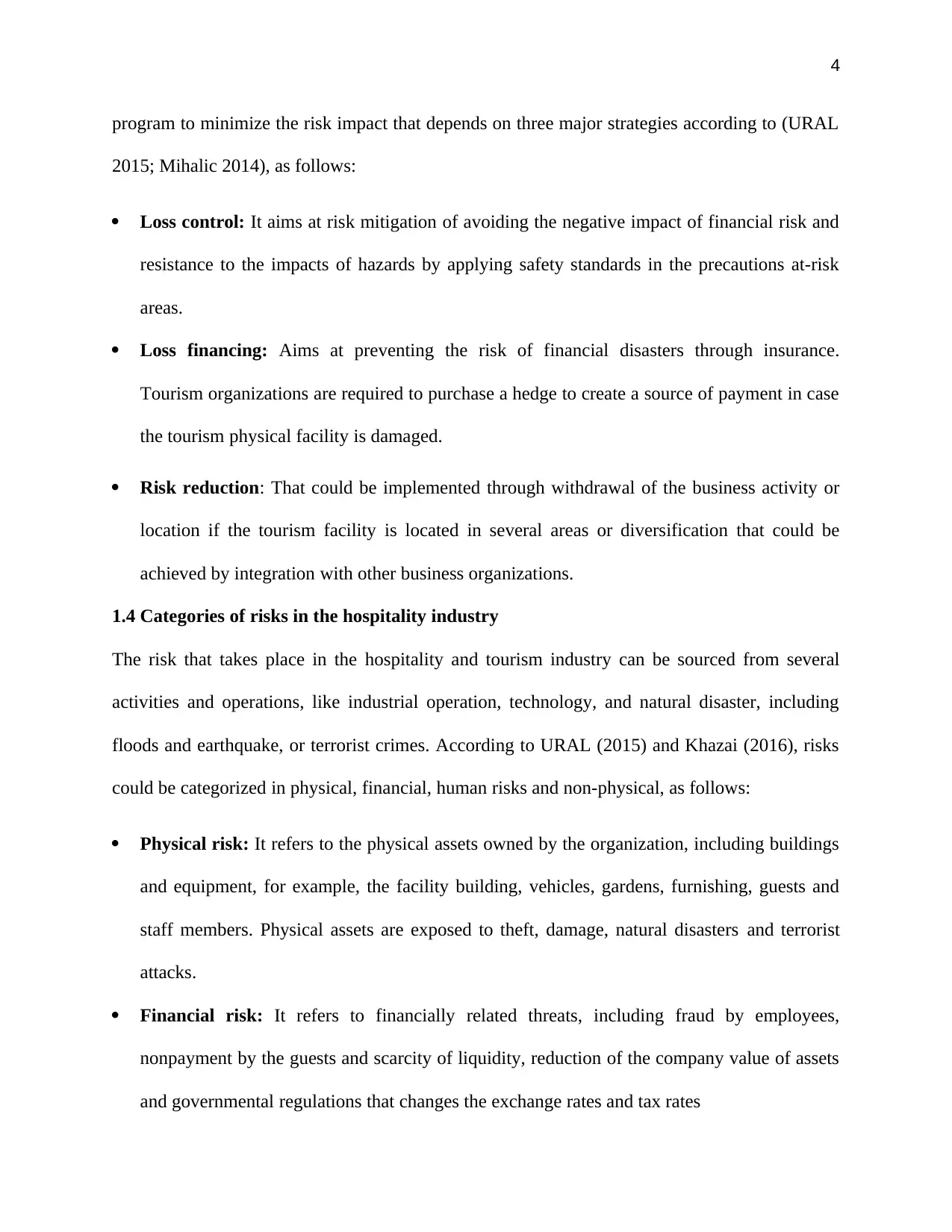
4
program to minimize the risk impact that depends on three major strategies according to (URAL
2015; Mihalic 2014), as follows:
Loss control: It aims at risk mitigation of avoiding the negative impact of financial risk and
resistance to the impacts of hazards by applying safety standards in the precautions at-risk
areas.
Loss financing: Aims at preventing the risk of financial disasters through insurance.
Tourism organizations are required to purchase a hedge to create a source of payment in case
the tourism physical facility is damaged.
Risk reduction: That could be implemented through withdrawal of the business activity or
location if the tourism facility is located in several areas or diversification that could be
achieved by integration with other business organizations.
1.4 Categories of risks in the hospitality industry
The risk that takes place in the hospitality and tourism industry can be sourced from several
activities and operations, like industrial operation, technology, and natural disaster, including
floods and earthquake, or terrorist crimes. According to URAL (2015) and Khazai (2016), risks
could be categorized in physical, financial, human risks and non-physical, as follows:
Physical risk: It refers to the physical assets owned by the organization, including buildings
and equipment, for example, the facility building, vehicles, gardens, furnishing, guests and
staff members. Physical assets are exposed to theft, damage, natural disasters and terrorist
attacks.
Financial risk: It refers to financially related threats, including fraud by employees,
nonpayment by the guests and scarcity of liquidity, reduction of the company value of assets
and governmental regulations that changes the exchange rates and tax rates
program to minimize the risk impact that depends on three major strategies according to (URAL
2015; Mihalic 2014), as follows:
Loss control: It aims at risk mitigation of avoiding the negative impact of financial risk and
resistance to the impacts of hazards by applying safety standards in the precautions at-risk
areas.
Loss financing: Aims at preventing the risk of financial disasters through insurance.
Tourism organizations are required to purchase a hedge to create a source of payment in case
the tourism physical facility is damaged.
Risk reduction: That could be implemented through withdrawal of the business activity or
location if the tourism facility is located in several areas or diversification that could be
achieved by integration with other business organizations.
1.4 Categories of risks in the hospitality industry
The risk that takes place in the hospitality and tourism industry can be sourced from several
activities and operations, like industrial operation, technology, and natural disaster, including
floods and earthquake, or terrorist crimes. According to URAL (2015) and Khazai (2016), risks
could be categorized in physical, financial, human risks and non-physical, as follows:
Physical risk: It refers to the physical assets owned by the organization, including buildings
and equipment, for example, the facility building, vehicles, gardens, furnishing, guests and
staff members. Physical assets are exposed to theft, damage, natural disasters and terrorist
attacks.
Financial risk: It refers to financially related threats, including fraud by employees,
nonpayment by the guests and scarcity of liquidity, reduction of the company value of assets
and governmental regulations that changes the exchange rates and tax rates
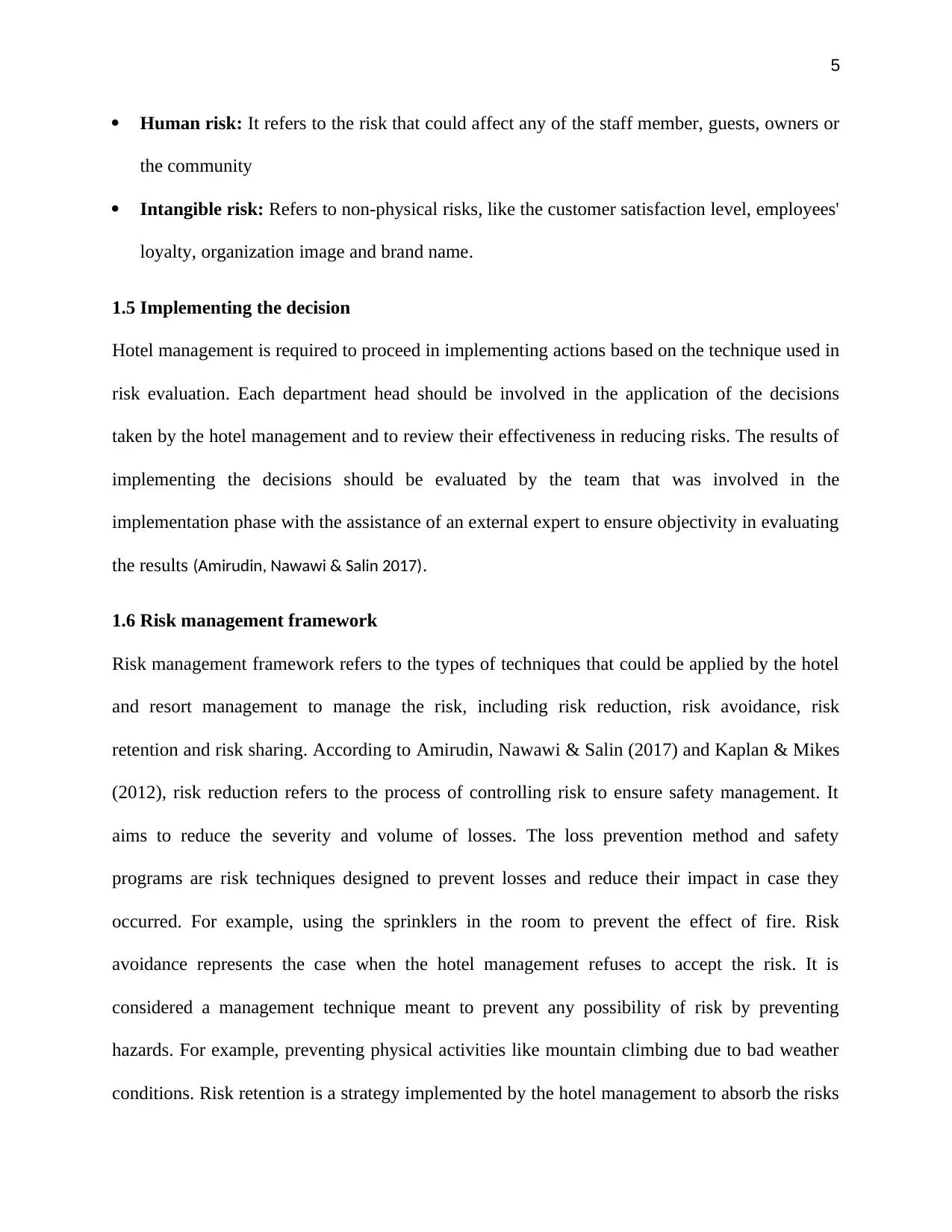
5
Human risk: It refers to the risk that could affect any of the staff member, guests, owners or
the community
Intangible risk: Refers to non-physical risks, like the customer satisfaction level, employees'
loyalty, organization image and brand name.
1.5 Implementing the decision
Hotel management is required to proceed in implementing actions based on the technique used in
risk evaluation. Each department head should be involved in the application of the decisions
taken by the hotel management and to review their effectiveness in reducing risks. The results of
implementing the decisions should be evaluated by the team that was involved in the
implementation phase with the assistance of an external expert to ensure objectivity in evaluating
the results (Amirudin, Nawawi & Salin 2017).
1.6 Risk management framework
Risk management framework refers to the types of techniques that could be applied by the hotel
and resort management to manage the risk, including risk reduction, risk avoidance, risk
retention and risk sharing. According to Amirudin, Nawawi & Salin (2017) and Kaplan & Mikes
(2012), risk reduction refers to the process of controlling risk to ensure safety management. It
aims to reduce the severity and volume of losses. The loss prevention method and safety
programs are risk techniques designed to prevent losses and reduce their impact in case they
occurred. For example, using the sprinklers in the room to prevent the effect of fire. Risk
avoidance represents the case when the hotel management refuses to accept the risk. It is
considered a management technique meant to prevent any possibility of risk by preventing
hazards. For example, preventing physical activities like mountain climbing due to bad weather
conditions. Risk retention is a strategy implemented by the hotel management to absorb the risks
Human risk: It refers to the risk that could affect any of the staff member, guests, owners or
the community
Intangible risk: Refers to non-physical risks, like the customer satisfaction level, employees'
loyalty, organization image and brand name.
1.5 Implementing the decision
Hotel management is required to proceed in implementing actions based on the technique used in
risk evaluation. Each department head should be involved in the application of the decisions
taken by the hotel management and to review their effectiveness in reducing risks. The results of
implementing the decisions should be evaluated by the team that was involved in the
implementation phase with the assistance of an external expert to ensure objectivity in evaluating
the results (Amirudin, Nawawi & Salin 2017).
1.6 Risk management framework
Risk management framework refers to the types of techniques that could be applied by the hotel
and resort management to manage the risk, including risk reduction, risk avoidance, risk
retention and risk sharing. According to Amirudin, Nawawi & Salin (2017) and Kaplan & Mikes
(2012), risk reduction refers to the process of controlling risk to ensure safety management. It
aims to reduce the severity and volume of losses. The loss prevention method and safety
programs are risk techniques designed to prevent losses and reduce their impact in case they
occurred. For example, using the sprinklers in the room to prevent the effect of fire. Risk
avoidance represents the case when the hotel management refuses to accept the risk. It is
considered a management technique meant to prevent any possibility of risk by preventing
hazards. For example, preventing physical activities like mountain climbing due to bad weather
conditions. Risk retention is a strategy implemented by the hotel management to absorb the risks
⊘ This is a preview!⊘
Do you want full access?
Subscribe today to unlock all pages.

Trusted by 1+ million students worldwide
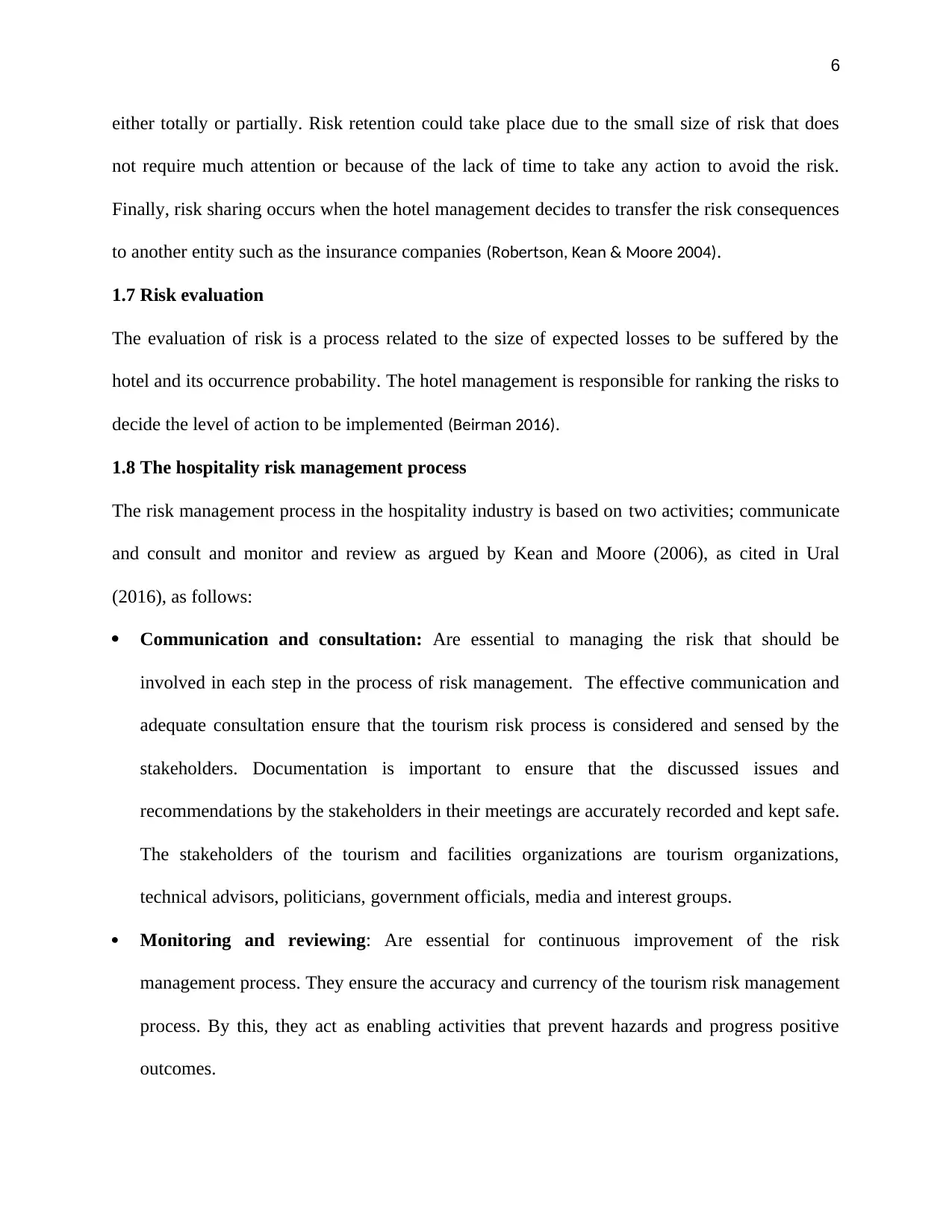
6
either totally or partially. Risk retention could take place due to the small size of risk that does
not require much attention or because of the lack of time to take any action to avoid the risk.
Finally, risk sharing occurs when the hotel management decides to transfer the risk consequences
to another entity such as the insurance companies (Robertson, Kean & Moore 2004).
1.7 Risk evaluation
The evaluation of risk is a process related to the size of expected losses to be suffered by the
hotel and its occurrence probability. The hotel management is responsible for ranking the risks to
decide the level of action to be implemented (Beirman 2016).
1.8 The hospitality risk management process
The risk management process in the hospitality industry is based on two activities; communicate
and consult and monitor and review as argued by Kean and Moore (2006), as cited in Ural
(2016), as follows:
Communication and consultation: Are essential to managing the risk that should be
involved in each step in the process of risk management. The effective communication and
adequate consultation ensure that the tourism risk process is considered and sensed by the
stakeholders. Documentation is important to ensure that the discussed issues and
recommendations by the stakeholders in their meetings are accurately recorded and kept safe.
The stakeholders of the tourism and facilities organizations are tourism organizations,
technical advisors, politicians, government officials, media and interest groups.
Monitoring and reviewing: Are essential for continuous improvement of the risk
management process. They ensure the accuracy and currency of the tourism risk management
process. By this, they act as enabling activities that prevent hazards and progress positive
outcomes.
either totally or partially. Risk retention could take place due to the small size of risk that does
not require much attention or because of the lack of time to take any action to avoid the risk.
Finally, risk sharing occurs when the hotel management decides to transfer the risk consequences
to another entity such as the insurance companies (Robertson, Kean & Moore 2004).
1.7 Risk evaluation
The evaluation of risk is a process related to the size of expected losses to be suffered by the
hotel and its occurrence probability. The hotel management is responsible for ranking the risks to
decide the level of action to be implemented (Beirman 2016).
1.8 The hospitality risk management process
The risk management process in the hospitality industry is based on two activities; communicate
and consult and monitor and review as argued by Kean and Moore (2006), as cited in Ural
(2016), as follows:
Communication and consultation: Are essential to managing the risk that should be
involved in each step in the process of risk management. The effective communication and
adequate consultation ensure that the tourism risk process is considered and sensed by the
stakeholders. Documentation is important to ensure that the discussed issues and
recommendations by the stakeholders in their meetings are accurately recorded and kept safe.
The stakeholders of the tourism and facilities organizations are tourism organizations,
technical advisors, politicians, government officials, media and interest groups.
Monitoring and reviewing: Are essential for continuous improvement of the risk
management process. They ensure the accuracy and currency of the tourism risk management
process. By this, they act as enabling activities that prevent hazards and progress positive
outcomes.
Paraphrase This Document
Need a fresh take? Get an instant paraphrase of this document with our AI Paraphraser
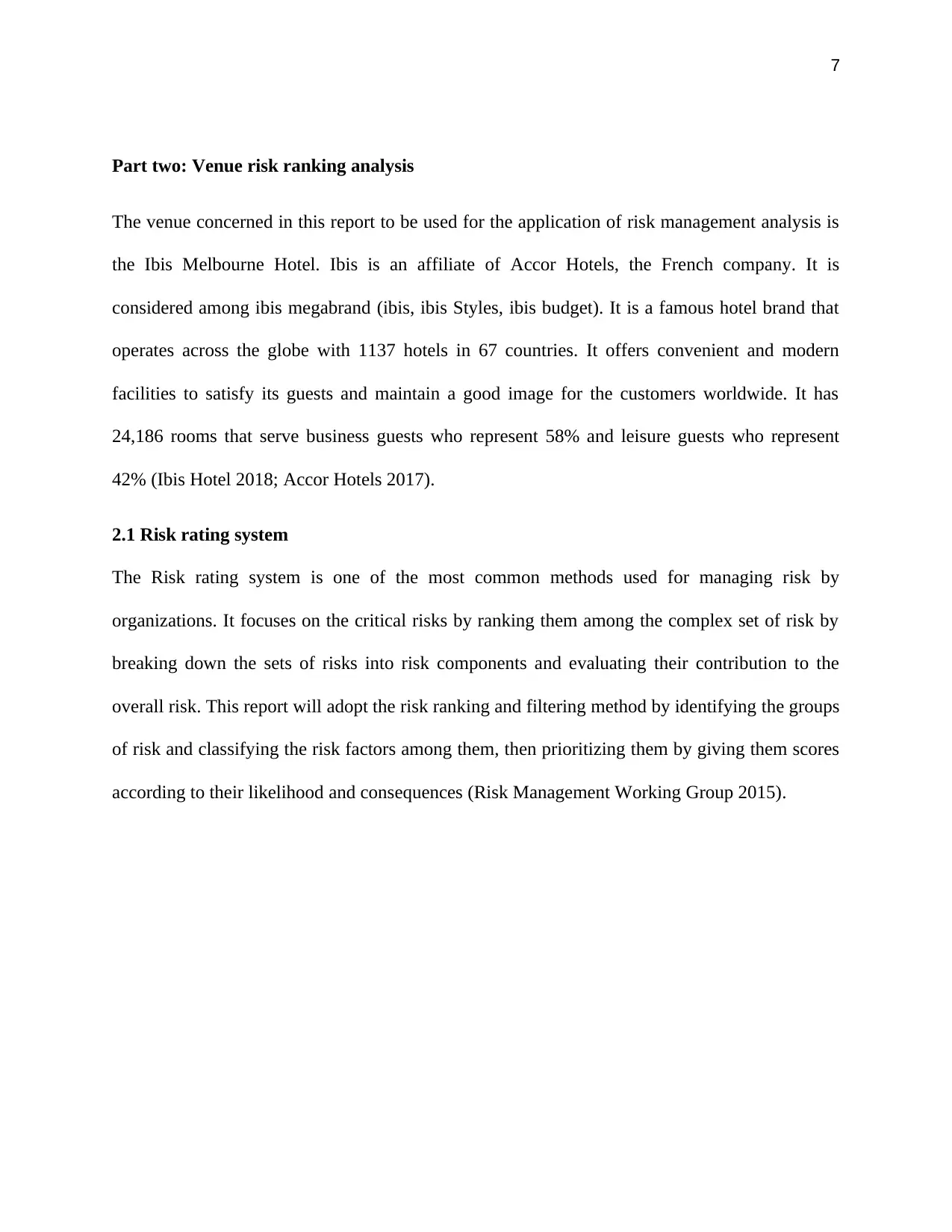
7
Part two: Venue risk ranking analysis
The venue concerned in this report to be used for the application of risk management analysis is
the Ibis Melbourne Hotel. Ibis is an affiliate of Accor Hotels, the French company. It is
considered among ibis megabrand (ibis, ibis Styles, ibis budget). It is a famous hotel brand that
operates across the globe with 1137 hotels in 67 countries. It offers convenient and modern
facilities to satisfy its guests and maintain a good image for the customers worldwide. It has
24,186 rooms that serve business guests who represent 58% and leisure guests who represent
42% (Ibis Hotel 2018; Accor Hotels 2017).
2.1 Risk rating system
The Risk rating system is one of the most common methods used for managing risk by
organizations. It focuses on the critical risks by ranking them among the complex set of risk by
breaking down the sets of risks into risk components and evaluating their contribution to the
overall risk. This report will adopt the risk ranking and filtering method by identifying the groups
of risk and classifying the risk factors among them, then prioritizing them by giving them scores
according to their likelihood and consequences (Risk Management Working Group 2015).
Part two: Venue risk ranking analysis
The venue concerned in this report to be used for the application of risk management analysis is
the Ibis Melbourne Hotel. Ibis is an affiliate of Accor Hotels, the French company. It is
considered among ibis megabrand (ibis, ibis Styles, ibis budget). It is a famous hotel brand that
operates across the globe with 1137 hotels in 67 countries. It offers convenient and modern
facilities to satisfy its guests and maintain a good image for the customers worldwide. It has
24,186 rooms that serve business guests who represent 58% and leisure guests who represent
42% (Ibis Hotel 2018; Accor Hotels 2017).
2.1 Risk rating system
The Risk rating system is one of the most common methods used for managing risk by
organizations. It focuses on the critical risks by ranking them among the complex set of risk by
breaking down the sets of risks into risk components and evaluating their contribution to the
overall risk. This report will adopt the risk ranking and filtering method by identifying the groups
of risk and classifying the risk factors among them, then prioritizing them by giving them scores
according to their likelihood and consequences (Risk Management Working Group 2015).
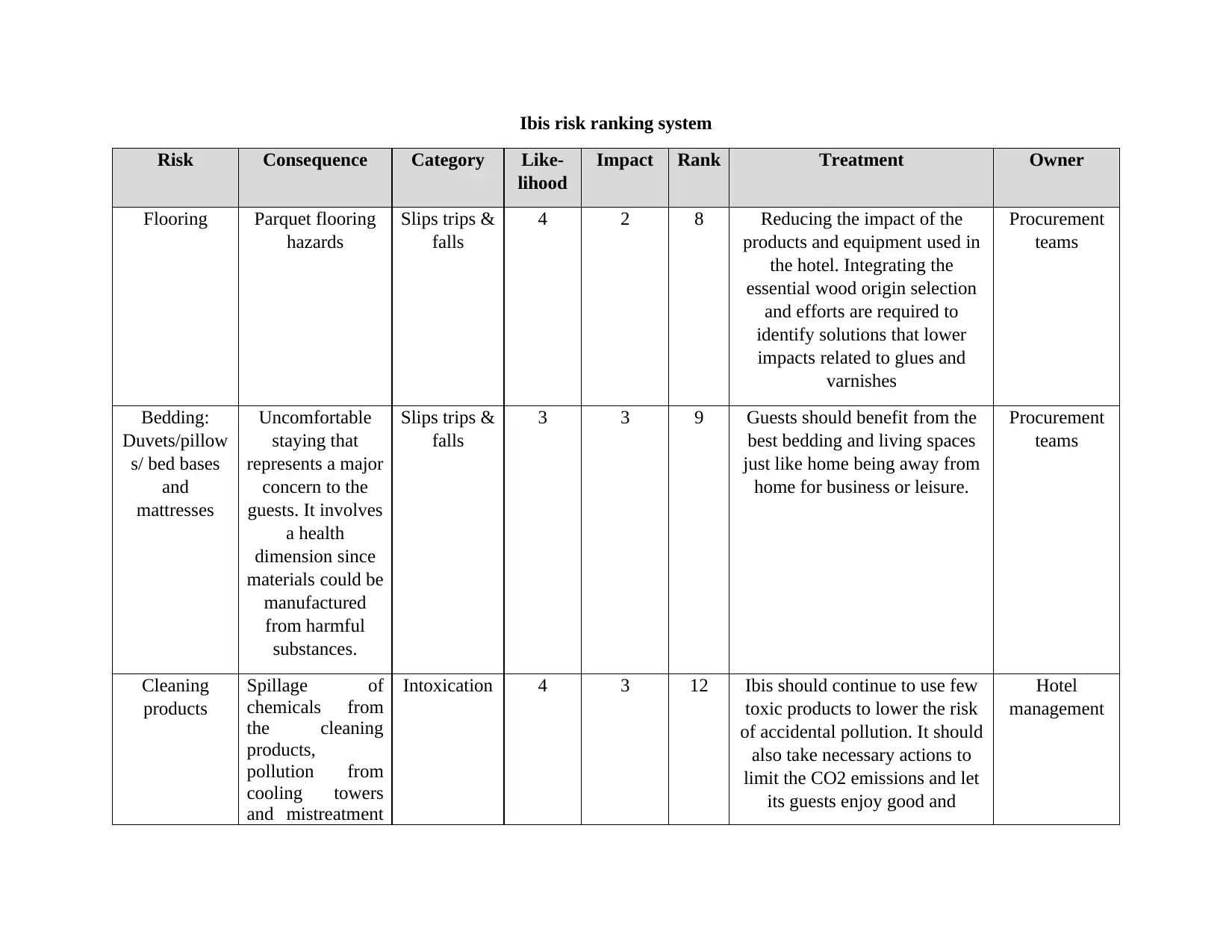
Ibis risk ranking system
Risk Consequence Category Like-
lihood
Impact Rank Treatment Owner
Flooring Parquet flooring
hazards
Slips trips &
falls
4 2 8 Reducing the impact of the
products and equipment used in
the hotel. Integrating the
essential wood origin selection
and efforts are required to
identify solutions that lower
impacts related to glues and
varnishes
Procurement
teams
Bedding:
Duvets/pillow
s/ bed bases
and
mattresses
Uncomfortable
staying that
represents a major
concern to the
guests. It involves
a health
dimension since
materials could be
manufactured
from harmful
substances.
Slips trips &
falls
3 3 9 Guests should benefit from the
best bedding and living spaces
just like home being away from
home for business or leisure.
Procurement
teams
Cleaning
products
Spillage of
chemicals from
the cleaning
products,
pollution from
cooling towers
and mistreatment
Intoxication 4 3 12 Ibis should continue to use few
toxic products to lower the risk
of accidental pollution. It should
also take necessary actions to
limit the CO2 emissions and let
its guests enjoy good and
Hotel
management
Risk Consequence Category Like-
lihood
Impact Rank Treatment Owner
Flooring Parquet flooring
hazards
Slips trips &
falls
4 2 8 Reducing the impact of the
products and equipment used in
the hotel. Integrating the
essential wood origin selection
and efforts are required to
identify solutions that lower
impacts related to glues and
varnishes
Procurement
teams
Bedding:
Duvets/pillow
s/ bed bases
and
mattresses
Uncomfortable
staying that
represents a major
concern to the
guests. It involves
a health
dimension since
materials could be
manufactured
from harmful
substances.
Slips trips &
falls
3 3 9 Guests should benefit from the
best bedding and living spaces
just like home being away from
home for business or leisure.
Procurement
teams
Cleaning
products
Spillage of
chemicals from
the cleaning
products,
pollution from
cooling towers
and mistreatment
Intoxication 4 3 12 Ibis should continue to use few
toxic products to lower the risk
of accidental pollution. It should
also take necessary actions to
limit the CO2 emissions and let
its guests enjoy good and
Hotel
management
⊘ This is a preview!⊘
Do you want full access?
Subscribe today to unlock all pages.

Trusted by 1+ million students worldwide
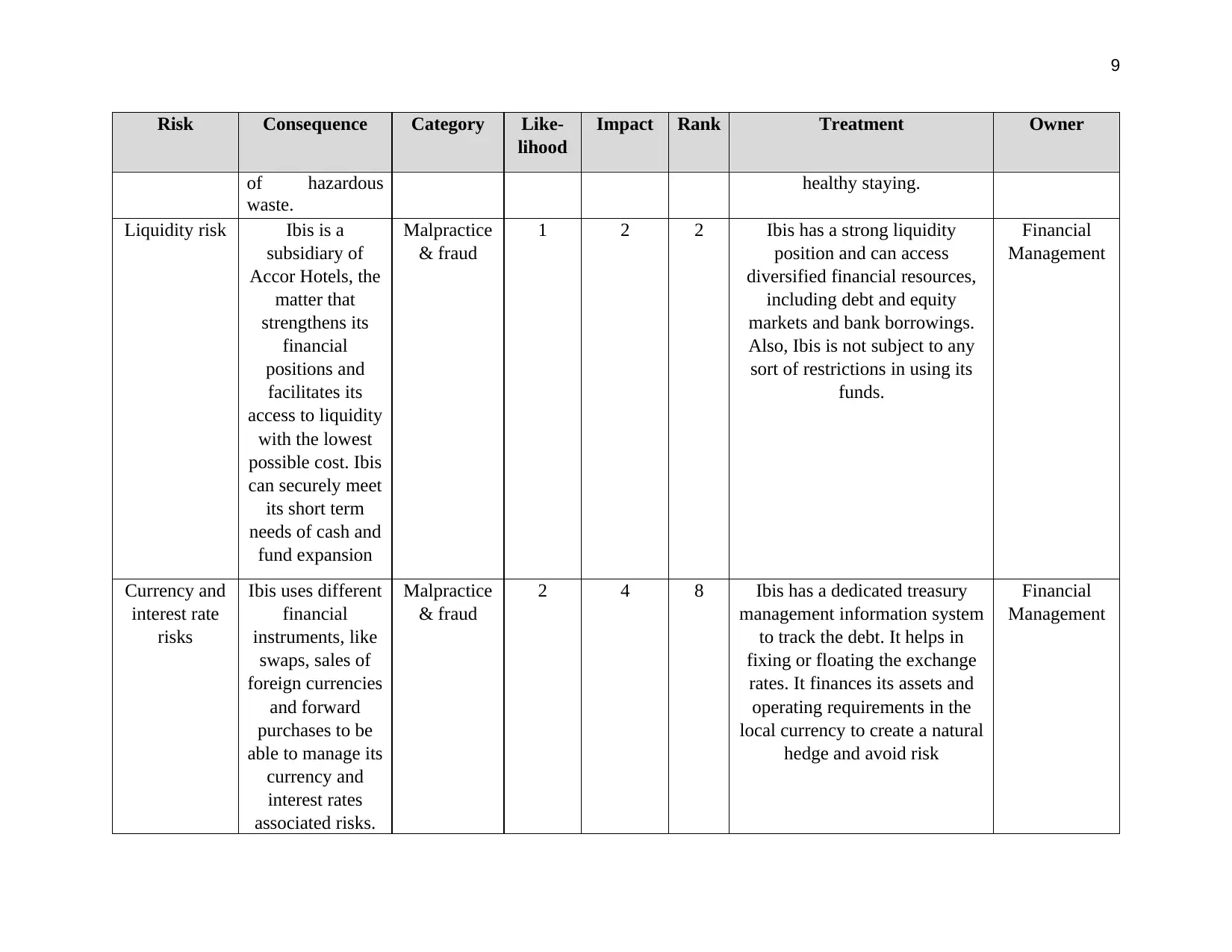
9
Risk Consequence Category Like-
lihood
Impact Rank Treatment Owner
of hazardous
waste.
healthy staying.
Liquidity risk Ibis is a
subsidiary of
Accor Hotels, the
matter that
strengthens its
financial
positions and
facilitates its
access to liquidity
with the lowest
possible cost. Ibis
can securely meet
its short term
needs of cash and
fund expansion
Malpractice
& fraud
1 2 2 Ibis has a strong liquidity
position and can access
diversified financial resources,
including debt and equity
markets and bank borrowings.
Also, Ibis is not subject to any
sort of restrictions in using its
funds.
Financial
Management
Currency and
interest rate
risks
Ibis uses different
financial
instruments, like
swaps, sales of
foreign currencies
and forward
purchases to be
able to manage its
currency and
interest rates
associated risks.
Malpractice
& fraud
2 4 8 Ibis has a dedicated treasury
management information system
to track the debt. It helps in
fixing or floating the exchange
rates. It finances its assets and
operating requirements in the
local currency to create a natural
hedge and avoid risk
Financial
Management
Risk Consequence Category Like-
lihood
Impact Rank Treatment Owner
of hazardous
waste.
healthy staying.
Liquidity risk Ibis is a
subsidiary of
Accor Hotels, the
matter that
strengthens its
financial
positions and
facilitates its
access to liquidity
with the lowest
possible cost. Ibis
can securely meet
its short term
needs of cash and
fund expansion
Malpractice
& fraud
1 2 2 Ibis has a strong liquidity
position and can access
diversified financial resources,
including debt and equity
markets and bank borrowings.
Also, Ibis is not subject to any
sort of restrictions in using its
funds.
Financial
Management
Currency and
interest rate
risks
Ibis uses different
financial
instruments, like
swaps, sales of
foreign currencies
and forward
purchases to be
able to manage its
currency and
interest rates
associated risks.
Malpractice
& fraud
2 4 8 Ibis has a dedicated treasury
management information system
to track the debt. It helps in
fixing or floating the exchange
rates. It finances its assets and
operating requirements in the
local currency to create a natural
hedge and avoid risk
Financial
Management
Paraphrase This Document
Need a fresh take? Get an instant paraphrase of this document with our AI Paraphraser
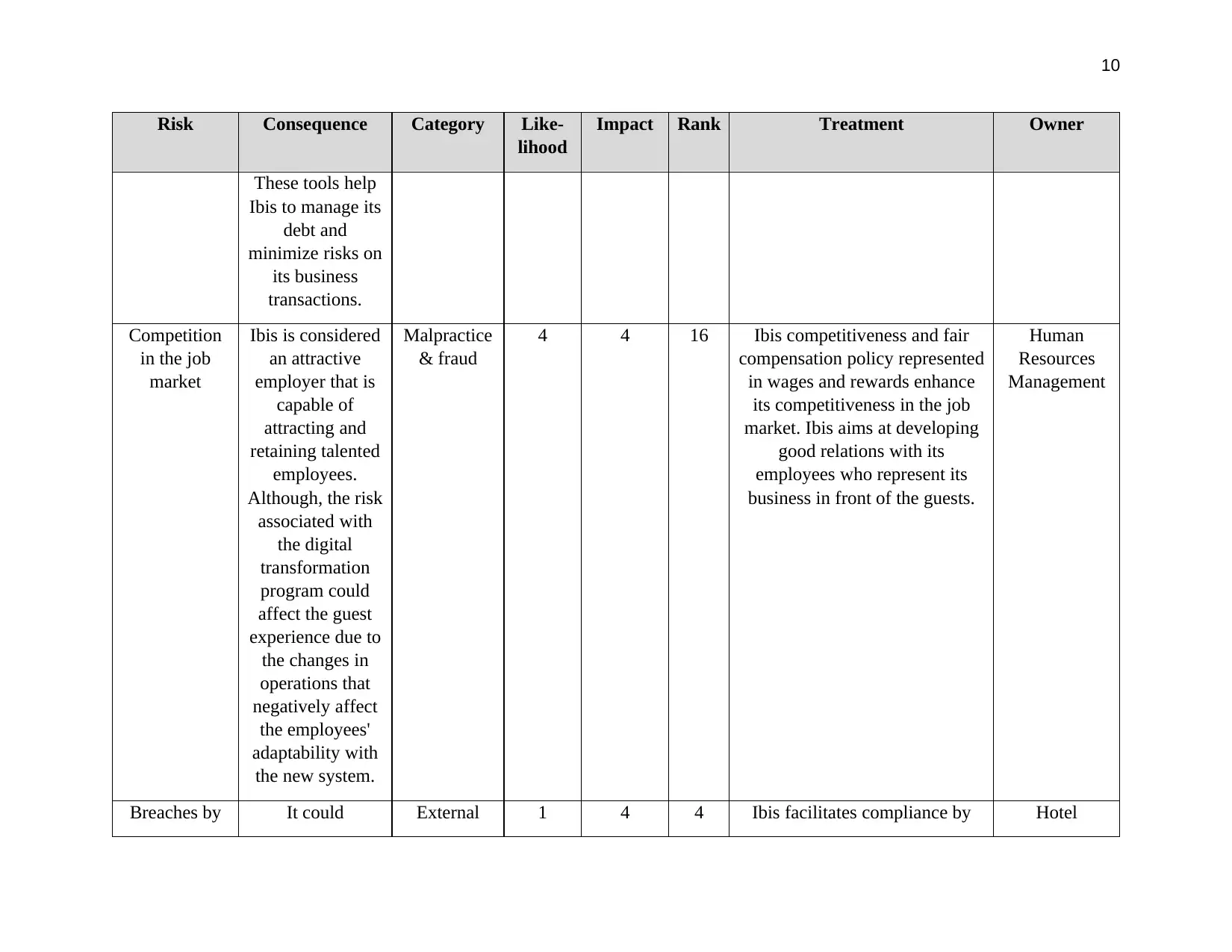
10
Risk Consequence Category Like-
lihood
Impact Rank Treatment Owner
These tools help
Ibis to manage its
debt and
minimize risks on
its business
transactions.
Competition
in the job
market
Ibis is considered
an attractive
employer that is
capable of
attracting and
retaining talented
employees.
Although, the risk
associated with
the digital
transformation
program could
affect the guest
experience due to
the changes in
operations that
negatively affect
the employees'
adaptability with
the new system.
Malpractice
& fraud
4 4 16 Ibis competitiveness and fair
compensation policy represented
in wages and rewards enhance
its competitiveness in the job
market. Ibis aims at developing
good relations with its
employees who represent its
business in front of the guests.
Human
Resources
Management
Breaches by It could External 1 4 4 Ibis facilitates compliance by Hotel
Risk Consequence Category Like-
lihood
Impact Rank Treatment Owner
These tools help
Ibis to manage its
debt and
minimize risks on
its business
transactions.
Competition
in the job
market
Ibis is considered
an attractive
employer that is
capable of
attracting and
retaining talented
employees.
Although, the risk
associated with
the digital
transformation
program could
affect the guest
experience due to
the changes in
operations that
negatively affect
the employees'
adaptability with
the new system.
Malpractice
& fraud
4 4 16 Ibis competitiveness and fair
compensation policy represented
in wages and rewards enhance
its competitiveness in the job
market. Ibis aims at developing
good relations with its
employees who represent its
business in front of the guests.
Human
Resources
Management
Breaches by It could External 1 4 4 Ibis facilitates compliance by Hotel
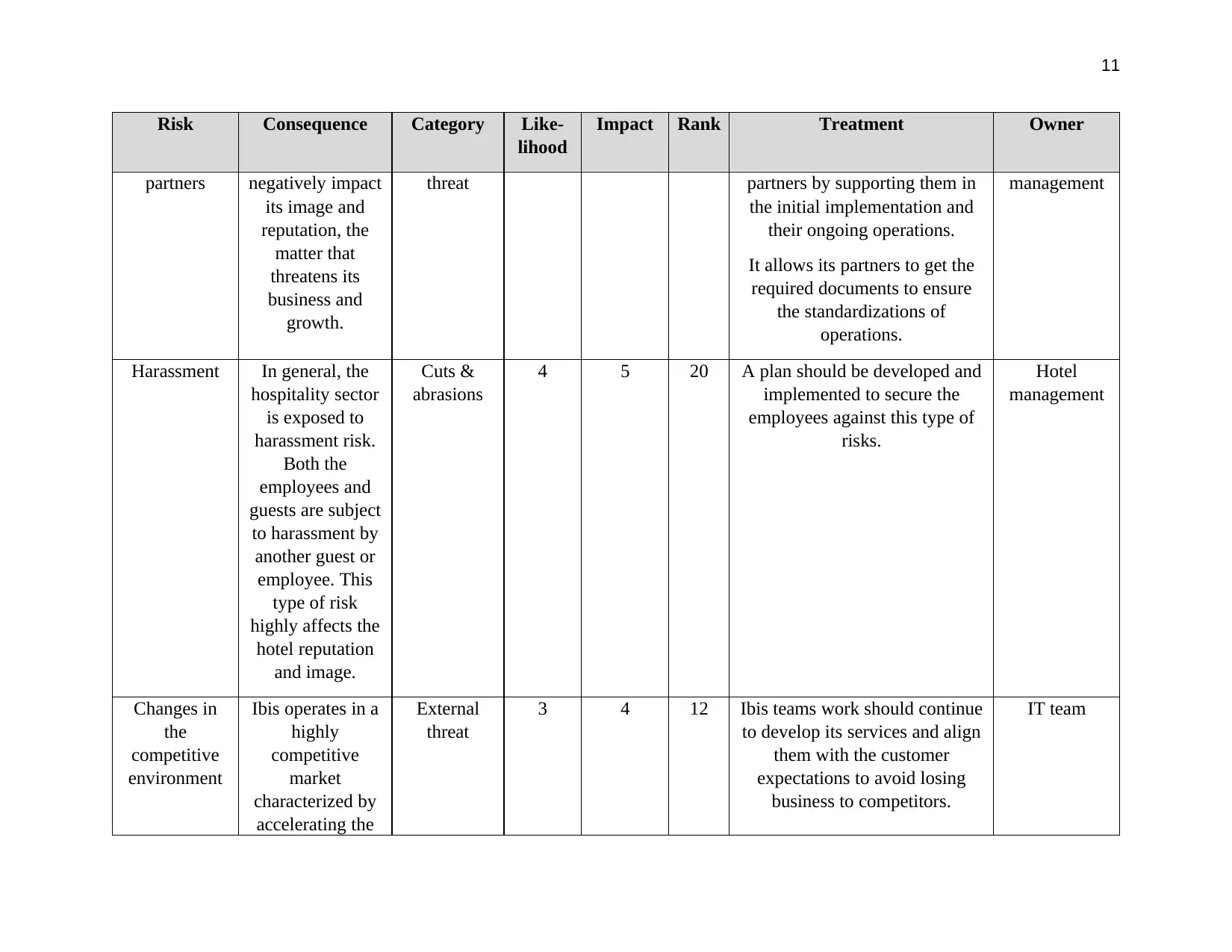
11
Risk Consequence Category Like-
lihood
Impact Rank Treatment Owner
partners negatively impact
its image and
reputation, the
matter that
threatens its
business and
growth.
threat partners by supporting them in
the initial implementation and
their ongoing operations.
It allows its partners to get the
required documents to ensure
the standardizations of
operations.
management
Harassment In general, the
hospitality sector
is exposed to
harassment risk.
Both the
employees and
guests are subject
to harassment by
another guest or
employee. This
type of risk
highly affects the
hotel reputation
and image.
Cuts &
abrasions
4 5 20 A plan should be developed and
implemented to secure the
employees against this type of
risks.
Hotel
management
Changes in
the
competitive
environment
Ibis operates in a
highly
competitive
market
characterized by
accelerating the
External
threat
3 4 12 Ibis teams work should continue
to develop its services and align
them with the customer
expectations to avoid losing
business to competitors.
IT team
Risk Consequence Category Like-
lihood
Impact Rank Treatment Owner
partners negatively impact
its image and
reputation, the
matter that
threatens its
business and
growth.
threat partners by supporting them in
the initial implementation and
their ongoing operations.
It allows its partners to get the
required documents to ensure
the standardizations of
operations.
management
Harassment In general, the
hospitality sector
is exposed to
harassment risk.
Both the
employees and
guests are subject
to harassment by
another guest or
employee. This
type of risk
highly affects the
hotel reputation
and image.
Cuts &
abrasions
4 5 20 A plan should be developed and
implemented to secure the
employees against this type of
risks.
Hotel
management
Changes in
the
competitive
environment
Ibis operates in a
highly
competitive
market
characterized by
accelerating the
External
threat
3 4 12 Ibis teams work should continue
to develop its services and align
them with the customer
expectations to avoid losing
business to competitors.
IT team
⊘ This is a preview!⊘
Do you want full access?
Subscribe today to unlock all pages.

Trusted by 1+ million students worldwide
1 out of 20
Related Documents
Your All-in-One AI-Powered Toolkit for Academic Success.
+13062052269
info@desklib.com
Available 24*7 on WhatsApp / Email
![[object Object]](/_next/static/media/star-bottom.7253800d.svg)
Unlock your academic potential
Copyright © 2020–2025 A2Z Services. All Rights Reserved. Developed and managed by ZUCOL.





